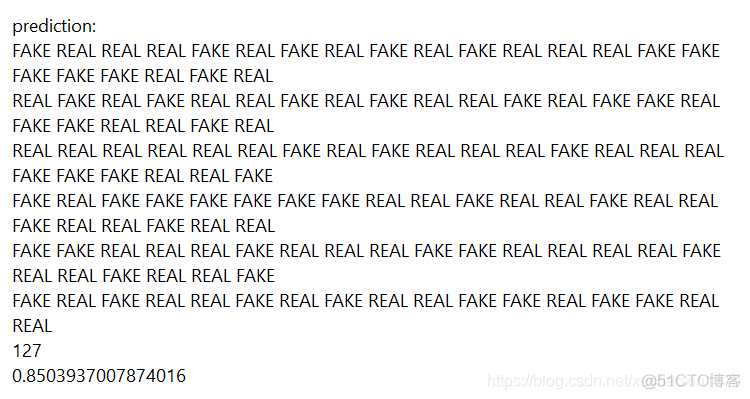文章目录 python code: result: python code: 使用tf-idf 提取特征向量 (语料库/文件集合中各个文件/新闻词条的特征向量来做分类(比如真假) from openpyxl import Workbook from openpyxl
文章目录
- python code:
- result:
python code:
使用tf-idf 提取特征向量
(语料库/文件集合中各个文件/新闻词条的特征向量来做分类(比如真假)
from openpyxl.utils.dataframe import dataframe_to_rows
from sklearn.feature_extraction.text import TfidfVectorizer
from sklearn.neighbors import KNeighborsClassifier
from sklearn.naive_bayes import GaussianNB
import numpy as np
import pandas as pd
import logging as l
l.basicConfig(level=l.DEBUG)
prefix = "./exp8/"
news_train = 'news_train.csv'
news_train_subset = "news_train_subset.csv"
news_test = "news_test.csv"
''' use the small scale input to test the process '''
# news_train = news_train_subset
# 读取原始数据,指定UTF-8编码
news_train_df = pd.read_csv(prefix + news_train, encoding='utf-8')
news_test_df = pd.read_csv(prefix+news_test, encoding="utf-8")
x_train = news_train_df['text']
len_train=len(x_train)
# print(len_train)
x_test=news_test_df['text']
# print(x_test)
# x=pd.merge(x,x_test,how="cross")
''' concat the two files
because the tf-idf algorithm reference to the corpus,so if you want to predict the news' validity ,you should create a corpus base all sentences'''
x_whole=pd.concat([x_train,x_test])
# print("new shape of x:")
# print(news_train_series)
# l.debug(f"{x}")
y = news_train_df['label']
#get the numeric label vector
y=[1 if validity=='REAL' else 0 for validity in y ]
# news_test_series = news_test_df['text']
# print(label_train_series)
# label_test_series=news_test_df['label']#this is waiting for solve(predict)
# news_train_series = np.array(news_train_series)
# print(news_train_series.shape)
# print(news_train_series)
# label_train_series = np.array(label_train_series)
# print(label_train_nd[1])
corpus = x_whole
# corpus_test=x_test
vectorizer = TfidfVectorizer()
# vectorizer_test=TfidfVectorizer()
v = vectorizer.fit_transform(corpus)
# v_test=vectorizer_test.fit_transform(corpus_test)
#get numeric x vector(ndarry)
x_whole_vectors=v.toarray()
# print(x_whole_vectors)
x_train_vectors=x_whole_vectors[:len_train]
x_test_vectors=x_whole_vectors[len_train:]
clf_GNB = GaussianNB()
y_test_estimate_real=[]
def estimate_accuracy():
''' estimate the accuracy: '''
estimate_number = int(0.9*len_train)
x_estimate = x_whole_vectors[:estimate_number]
y_estimate = y[:estimate_number]
# #fix the shape
x_test_estimate = x_whole_vectors[estimate_number:len_train]
global y_test_estimate_real
y_test_estimate_real = y[estimate_number:len_train]
''' estimate clf and operation:,if you want predict the finally result,the comment the following lines '''
clf_GNB.fit(x_estimate,y_estimate)
global y_predict
y_predict=clf_GNB.predict(x_test_estimate)
''' # change the references to estimate '''
# x = x_estimate
# y = y_estimate
y_predict=[]
def predict():
''' the ultimately prediction classifer and predict operation '''
clf_GNB.fit(x_train_vectors, y)
global y_predict
y_predict = clf_GNB.predict(x_test_vectors)
print("prediction:")
def output_prediction():
with open(prefix+"pred.txt","w") as fos:
for validity in y_predict:
if validity==1:
fos.write("REAL\n")
print("REAL",end=" ")
else:
fos.write("FAKE\n")
print("FAKE",end=" ")
print()
estimate_accuracy()
# predict()
output_prediction()
def print_for_estimate_accuracy():
''' begin estimate the prediction accuracy:80% or so '''
count=0
for i,j in zip(y_test_estimate_real,y_predict):
if i!=j:
count+=1
# print(i,j)
predicts_numbers=len(y_predict)
print(predicts_numbers)
print((predicts_numbers-count)/predicts_numbers)
print_for_estimate_accuracy()
result:

